Celebrate 70 Years of AMC with 10 of Our Favorite Cars
AMC was founded on May 1, 1954, when Hudson Motor Car Company and Nash-Kelvinator Corporation merged to better compete and survive against the Big Three. The plan worked, to an extent: AMC outlived Studebaker, Packard, and Kaiser-Jeep, the latter of which survived the longest, making it to 1970 before it was acquired by AMC. In 1987 AMC itself was purchased by Chrysler, and today only Jeep survives.
Over the brand’s 33-year run, it built family haulers, sports cars, off-roaders, and innovative compacts with a fraction of the resources of the Big Three, and the models often punched above their weight in performance and style. To celebrate the brand’s 70th anniversary, we’ve picked 10 of our top AMC models to highlight, in roughly chronological order, along with picks of our favorite variant from each model.
AMC Ambassador
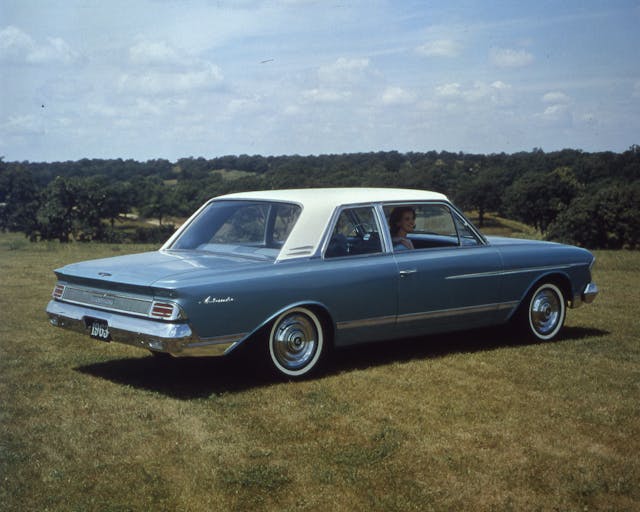
AMC’s full-size car was built in eight generations from 1958 to 1974 and could be had in a wide range of body styles, which often changed yearly, typical of its Big Three competition in that era. A rare sight at car shows, these big cruisers are bursting with style, as the Ambassador often served as the flagship model for AMC. In 1968, Ambassadors came equipped with standard air-conditioning while the feature was still optional across most of the industry, even on much more expensive models.
Our pick: While we love the funky, finned, ’50s four-door hardtop wagons, as well as the stylish two-door hardtops, we’ve got to go with the 1965–66 wagon. The interesting front-end treatment, with stacked headlights and horizontally mirrored grille, makes it look almost like a concept car. It was practically built for a Route 66 road trip. Besides, most of the rest of our picks are gonna be two-doors—we’ve got to be at least a little bit practical.
AMC Rambler American
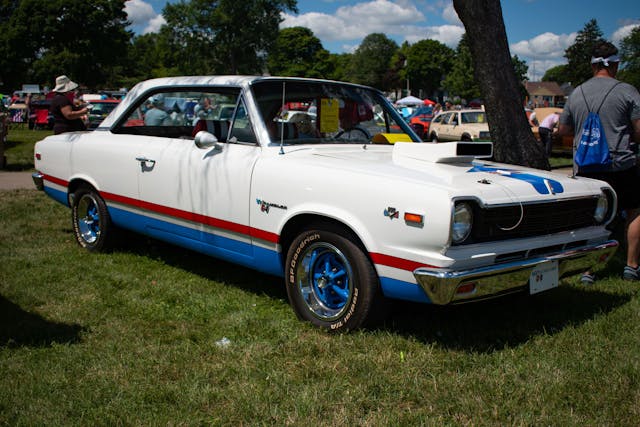
Built over three very different generations, the Rambler began as an elegant, sleek compact that stood out from the larger cars that were then dominating the market; it practically looked like a European import. The third generation introduced V-8 power to make a compact muscle car, the SC/Rambler, that would take on the sportier variants of the Dodge Dart, Ford Falcon, and Chevy Nova.
Our pick: The SC/Rambler with its red, white, and blue paint scheme is an easy choice, but we’ll go with some of AMC’s later models when it comes to patriotic color schemes. For our favorite Rambler, we’re gonna cheat a bit and pick an IKA Torino, which is what you get when Pininfarina gives this AMC a makeover. Built and sold by Industrias Kaiser Argentina and later Renault, the South American models were made famous thanks to their racing prowess. We’ll be honest, we wouldn’t care if they never took a checkered flag; we’re just interested in the looks.
AMC Rambler Marlin
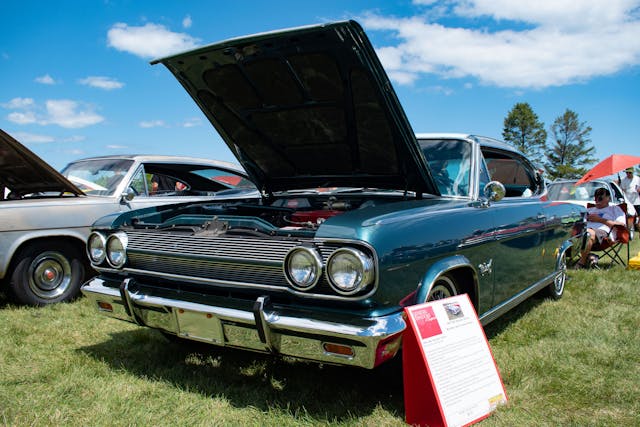
AMC’s midsize Rambler Classic spawned the fastback Rambler Marlin, whose sleek lines inspired Dodge to build the first-generation Charger. After just two years, Marlin moved to the larger Ambassador platform and kept the fastback design.
Our pick: We’re going to select the first-year Marlin, the 1965 model, which essentially serves as our favorite version of the Rambler Classic as well.
AMC Javelin
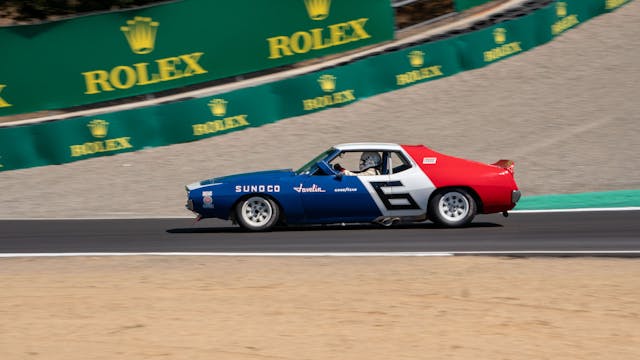
Whether it’s the rather understated early versions or the audacious, flared variants that came later, AMC’s take on the pony car is an attractive package. Like any good pony car, the Javelin was available with options to customize the style and performance, with several potent V-8 available. A blue, white, and red Javelin campaigned by Mark Donohue in 1971 brought the Trans Am championship to AMC for the first time, and in 1972, AMC nabbed driver George Follmer to repeat the performance.
Our pick: The one-year-only 1970 models featured a unique front end that is just different enough to notice from a distance. We’ll go with a 390 V-8 and a four-speed, in the red, white, and blue paint scheme that was the opposite orientation of the SCCA models.
AMC AMX
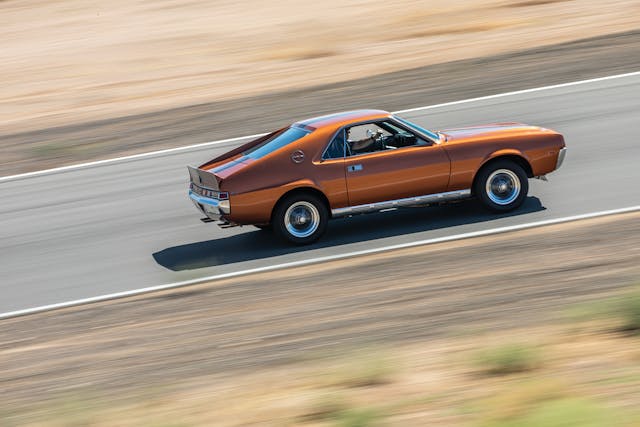
To create a two-door sports car and compete with Chevrolet’s Corvette, AMC shortened the Javelin and restyled it from the doors back. It’s a cost-cutting theme to which the company would return, but the AMX was arguably the best implementation of the strategy. AMC was proud to announce that the AMX started at less than $4000, the price of a loaded Mustang or Camaro. Production lasted from 1968 to 70, at which point “AMX” became an option package for the Javelin, then the Hornet, and eventually the Spirit.
Our pick: The AMX came standard with a V-8 and a four-speed with Hurst shifter, so pick your favorite AMC V-8, pick your favorite color, and go.
AMC Rebel

AMC’s mid-size follow-up, the Rambler Classic, filled a lot of roles as it was built in convertible, sedan, coupe, and wagon body styles. All of them look good, with interesting design cues like fenders and quarter panels with bulges to mimic the lines of their close-fitting bumpers, a design feature shared with the 1967–68 Ambassador.
Our pick: For style, it’s tough to beat the sleek looks of the 1967–69 hardtop, but we’ll still have to go with the 1970 Rebel Machine. It featured a 340-hp 390 V-8 that breathed through a sizable hood scoop and was available with a red, white, and blue paint scheme. It was loud, it was brash, and it was a solid performer thanks to a more powerful V-8 than even the AMX had. What’s not to love?
AMC Hornet

The compact Hornet sedan, successor to the Rambler American, was offered in two- and four-door variants when it debuted in 1970. A year later, it was joined by the Sportabout wagon, which AMC proudly claimed was “America’s only compact station wagon.” A sporty two-door hatchback joined the party in 1973. All of the body styles are rather attractive in their simplicity; perhaps that’s why we think they’ve aged so well. The muscular SC/360 version used a, you guessed it, 360 V-8 engine and was offered in muscle-car-appropriate colors and with a ram air induction system.
Our pick: While the most famous Hornet has to be the red hatchback from The Man With the Golden Gun (1974), the car that completed the miraculous corkscrew jump, we’ll take an earlier SC/360 model. How about a 1971 with the optional four-barrel, 285-hp engine with dual exhaust, four-speed manual, and 3.91:1 rear-axle ratio with Twin-Grip differential?
AMC Gremlin

AMC was used to being an underdog and doing a lot with a little. When it needed a more affordable, smaller car, it took the already compact Hornet, cut out 12 inches of wheelbase, and hacked off the rear to create the Gremlin. Sound familiar? Compared to the wonderfully proportioned AMX-GT concept that spawned the truncated subcompact, the Gremlin is a bit awkward. That doesn’t stop us from loving the odd little hatchback.

Our pick: Our initial thought was this wild, tracked Gremlin we spotted at SEMA in 2022, but how about something a bit more practical—a 1972 Gremlin X in Wild Plum? The 304 V-8 wasn’t a brutal powerhouse at the time, yet it was still punchy in the lightweight Gremlin. A modern tune-up with a decent cam and intake would make it a zippy runabout.
AMC Pacer
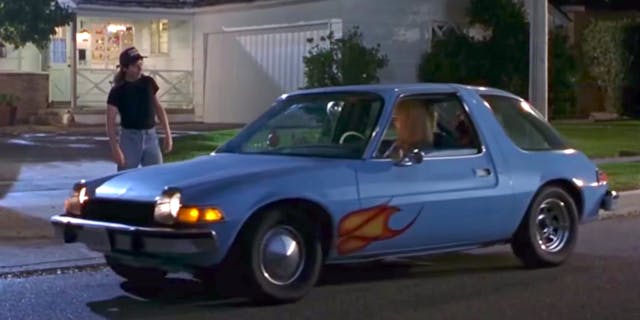
You can’t say that AMC was averse to taking risks. The Pacer offered unique, even strange styling with some practical benefits. The most oft-cited example is, of course, the passenger side door, which was longer than the driver’s to encourage rear-seat passengers to enter and exit on the curb side, where it was safer. The efficiently packaged interior offered fantastic visibility thanks to a greenhouse that used more window area. The car was also designed to be easy to repair.
Our pick: Our favorite Pacer has got to be the Mirthmobile, the only famous Pacer in existence. With a roof-mounted red rope licorice dispenser and a dash-mounted cup dispenser to go along with what appears to be an on-board water supply, it has tremendous road-trip potential.
AMC Eagle

These utilitarian sedans and wagons aren’t particularly eye-catching and would have blended in with plenty of their contemporaries if it weren’t for the fact that they rode a bit taller on their 4×4 suspensions. The drivetrain made them a precursor to the ubiquitous crossover and served to highlight AMC’s ambitious attempts to carve out new segments in the market. The Eagle sedans and wagons were based on the Concorde, the successor to the Hornet.
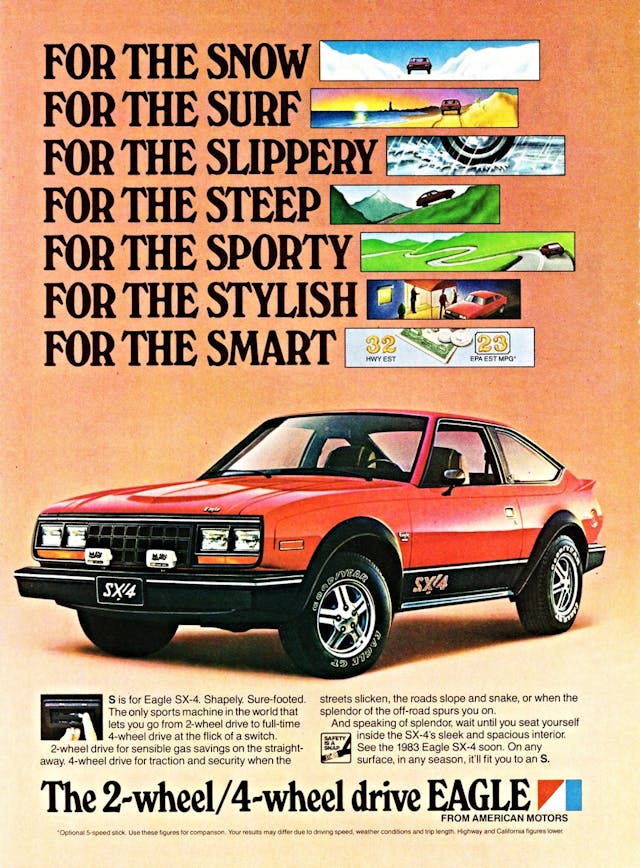
Our pick: The SX/4 three-door that was based on the smaller AMC Spirit is a rare sight today and would make for a fun rallycross-inspired toy.
Bonus:
XJ Jeep Cherokee

The XJ wasn’t branded as an AMC, but AMC was Jeep’s steward from 1970 to 1987 and the Cherokee was AMC’s largest contribution to the brand over that period, as most of the other models available were carryovers from Kaiser.
These boxy wagons weren’t the first compact SUV, although they set the stage for the future in several important ways. With lightweight unibody construction and a solid front axle with coil-spring suspension, the XJ Cherokee was maneuverable and capable off-road and had a decent ride on-road. Its quadra-link suspension made its way to the original Grand Cherokee in 1993 and TJ Wrangler in 1997. The Grand Cherokee was initially planned to replace the Cherokee, although strong sales kept the XJ in production until 2001 in the United States. Reskinned versions were on sale in China until 2014.
Our pick: A 1997–99 4.0-liter model to get the best of the upgrades that started in 1997 but the last of the high-pinion Dana 30 front axles.
This list had to be cut short, but we’ve managed to cover a pretty big swath of AMC’s lineup. Our favorites were biased toward the ’60s and ’70s, so let us know if we’ve overlooked your number-one AMC.
***
Check out the Hagerty Media homepage so you don’t miss a single story, or better yet, bookmark it. To get our best stories delivered right to your inbox, subscribe to our newsletters.
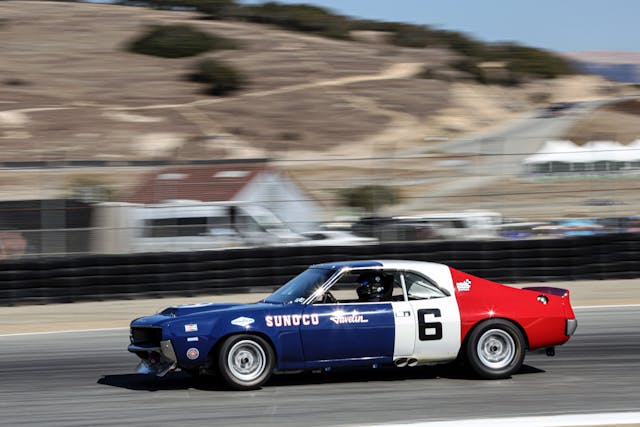
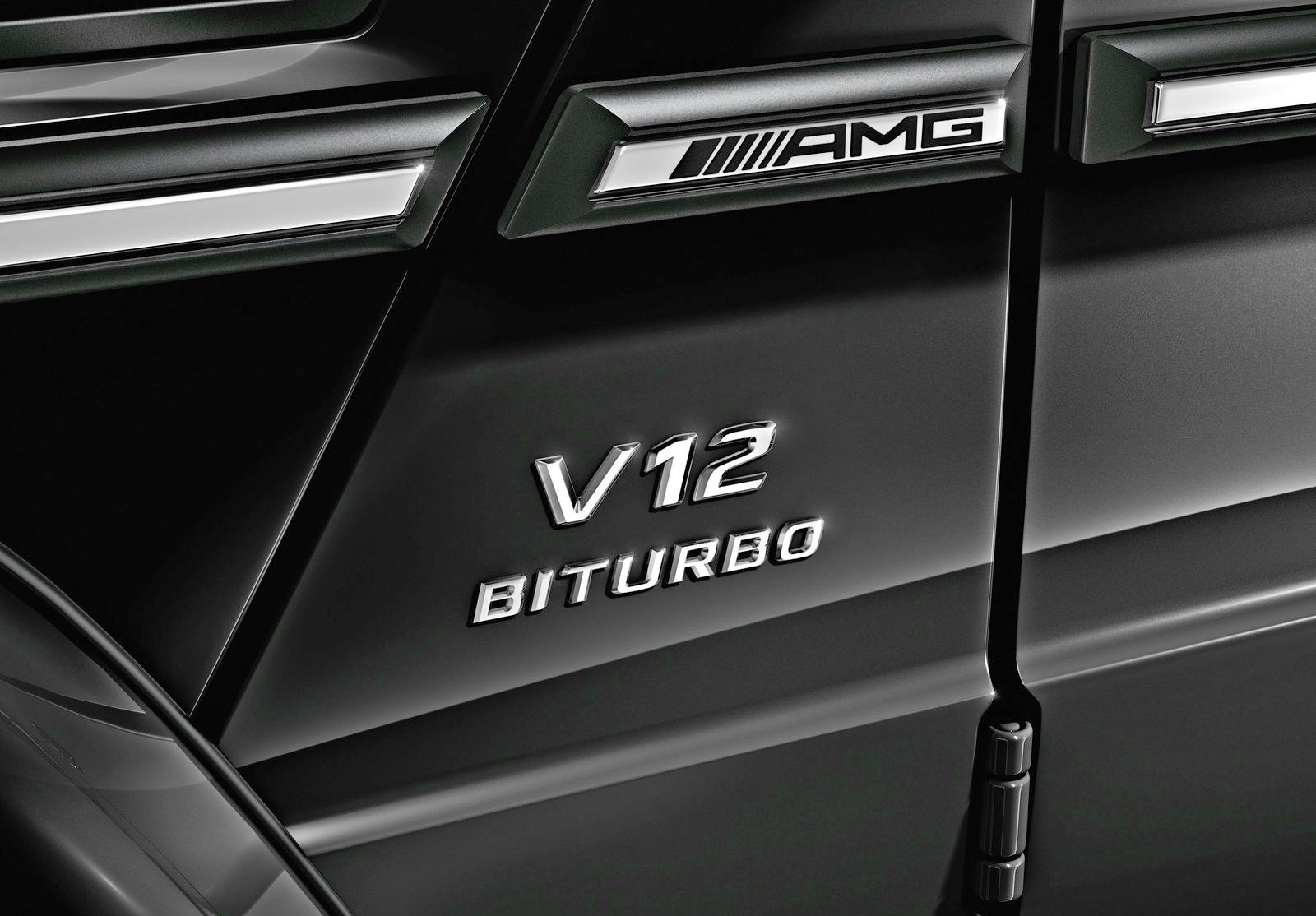

I owned a Javelin/AMX while in college. Fun car. Paid $400 for it and drove it for 4 years when I sold it for a 914 my dad and I had rebuilt after an engine fire.
l agree with Mark M above. The ’67’s were much nicer. And can’t believe you left out the’57 Rebel.
The bred-and-butter Hornets were nothing to “write home about”. l had a ’76 for 3 years and it was “adequate”. l had a ’64 Studebaker Commander that l drove for 2 years just after the Hornet (true!) and the Stude was, if anything, and upgrade.
The Marlins had great interiors, but sold poorly for a company that was supposed to be dynamic. It BARELY outsold Studebaker’s ’62-64 Gran Turismo Hawks (even though GT Hawks were only made until December ’63).
My best friend in high school (and still) had a ’67 Mustang 289 fastback that was crazy quick off the line. He never lost impromptu stoplight tag races in suburban Detroit save once–to a 390 Javelin.
I bought a 74 Hornet X Hatchback new. It was white with blue & red stripes on the sides and a red stripe in the center of the grille. My Hornet had a 2 barrel 360/727, floor shift, and 3:54 rear drivetrain. Did some re-tuning (distributor recurve) reconfigured (disabled) the emissions, and installed headers. My X had no a/c, but it had the better a/c suspension. Got a 74/75 Vette? Eat my dust!
I bought a new AMC Spirt GT in 1981. It came with rally wheels and all the nice GT gauges and a 4 speed, plus the Pontiac “Iron Duke” 151 CID motor. And rear wheel drive. All in all it was more bang for your buck than the Mustang.
I’ve had so many….. only bought one new car in my life, 1985 eagle wagon that was so expensive that I vowed to keep it forever. Well, it wasn’t forever, but did have it 20 years when I decided to move on. 71 javelin AMX that I painted red white and blue in honor of Mark. My current ride is my 67 rambler rogue convertible that I got in 2003 after looking for one since the early 80’s. Convertible rogues were only made in 67 with a production of 923 cars, so, pretty hard to find. Unfortunately no convertibles were offered in 68 or 69 on the American platform. Mine is stock, but have seen a few people do them up to look like a SC/RAMBLER which are sharp.
We had a 65′ Classic 550 w/327 4bbl. It was ‘the value added things’ that made Ramblers such a good buy – such as ‘dual circuit brakes’ (years before offered on other domestics); Weather Eye heater (powerful); Ceramic armored exhaust- and other quirky little things – like ‘pillows’ matching the upholstery.
WE WERE AN AMERICAN MOTORS FAMILY, TWO AMERICANS & A GREMLIN. TOO BAD WHEN THEY CHOPPED OFF THE REAR OF THE HORNET TO MAKE THE GREMLIN IT DIDN’T LOOK AS SHARP AS THE AMX.
I recall one pundit calling the Marlin a “fastback panel truck.” Yep, it was too big.
Desperately wanted an AMX when I got out of the Army, but, alas, financial reality got to me. It was different enough to really catch my eye, but as the article notes, it went from a model to a trim package in just a few years.
I also thought the Eagle was a clever idea. Another car I would strongly consider if I had a do-over.w
The fastest car I owned growing up was a 69 AMX with a 390 and a a BW 4 speed. All the guys I ran around with laughed at me when I traded my Firebird 326 HO for it. They called it my Kelvinator; until they tried to go up against it.
I believe the ‘door handles’ were actually made by Kelvinator!
AMC did not shorten the Javelin to make the AMX. Popular story, but its a myth.
WRONG!!! 1968-1970 were shortened by taking about a foot out of the wheelbase. My buddy had a 1969 AMX for a short period of time in addition to his 1972 Javelin SST. The ’69 was considerably shorter in length. He sold the the AMX because he’s more of a “cruiser” guy and not a racer. The AMX was a 390 GO-PACK car with a 4 speed and 3:54 twin grip rear. He still has the 1972 because of the styling and comfort. It has a 304 with the 904 Torqueflite tranny.
As the owner of a ’65 Ambassador 990 Cross Country, I was very happy, and surprised, to read that it is the representative for the Ambassadors! The other generations deserve recognition, too, and often the ’65-’66s are forgotten, but they are very handsome cars.
We have quite a few AMCs. including a ’66 Marlin, a ’72 Wagoneer, a ’73 Ambassador, a ’77 Hornet, an ’80 Concord and an ’84 Eagle.
70 years since 1954, yet not a single Nash or Hudson on the list. No Nash Ambassador and no Hudson Hornet? I am confused and a happy Nash owner
Had a1973 Hornet with a 232. Nice car, and the engine was indestructible. Wish I kept it.